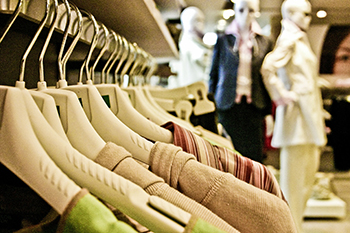 I’m sure that many of us are guilty of owning a wardrobe full of clothes but still sometimes feeling that we have nothing to wear. If not yourself, you probably know someone who fits that description, and the likelihood is that a sense of not having the ‘right’ thing to wear will lead to shopping for more.
I’m sure that many of us are guilty of owning a wardrobe full of clothes but still sometimes feeling that we have nothing to wear. If not yourself, you probably know someone who fits that description, and the likelihood is that a sense of not having the ‘right’ thing to wear will lead to shopping for more.
The availability of relatively cheap clothing and ‘fast fashion’ trends is an influencing force in consumer culture that persistently nudges people towards buying more and more clothing whether they need it or not. Inevitably much of this excess finds its way into landfill. Whilst the efforts of fashion retailers to improve sustainability in the manufacture of their products should absolutely be applauded, landfill is still overflowing with textiles including organic cotton.
It follows that, like it or not, the most effective way to improve clothing sustainability might be to make and buy less of it.
So, would the day we choose to buy fewer clothes be a sad occasion for British women? It would not necessarily be detrimental to the fashion industry, after all, buying fewer items does not automatically mean spending less money.
In my study at Coventry University I am exploring female attitudes towards the notion of buying fewer garments.
I have found, unsurprisingly, that anticipating, browsing for, choosing, buying and wearing clothes provides women with a great deal of happiness. Motivated by pleasure and variety seeking to an extent, but also by the desire to measure up to social expectations, frequent shopping patterns are exhibited by women across a wide variety of ages and income levels.
This might suggest that our passion for fast fashion is not something that would be easily relinquished however, many of the women that I have spoken with have experienced dissatisfaction with the resulting contents of their wardrobes.
Descriptions of cupboards crammed with unworn impulse purchases, disappointment with cheaper items that do not wear well and regrets when they total up what has been spent and imagine the ‘better’ garment choices that could have been made instead.
Examples from my interviewing include:
“when you buy cheap clothes, they never wash well, they break quite easily and tear and little things go wrong, but I find the more expensive clothes I've bought, the more guilt was attached to it at the time but that could last easily ten years and it would wash well and always make me feel great”
“at the moment I can't get anything else in my wardrobe and I only wear about thirty percent of it ….. most of the unworn stuff has been impulse buys, I should be more careful really”
“I know I've been so disappointed with some of the cheaper stuff I've bought and I thought well if I added all that together and bought something that was really nice it would probably do me more favours”
Comments such as these indicate that by selecting fewer, well considered and sometimes better quality garments it may be possible to achieve the sustainability benefits associated with buying fewer garments whilst being equally, if not more satisfied with the contents of our wardrobes.
My study aims to explore the feasibility of this ‘win win’ situation by investigating what happens when existing clothes shopping patterns are challenged.
To find out more about the project and the author, visit the Coventry university website.

The Life Story of your T-shirt
This blog was written as part of an online event run by The Institute for Social Marketing as part of the Festival of Social Science week (7th-14th November 2015).
Visit our event hub to learn more about how t-shirts are made, make decisions about sustainability and share the story of your own favourite t-shirt.
Rate and Review
Rate this article
Review this article
Log into OpenLearn to leave reviews and join in the conversation.
Article reviews